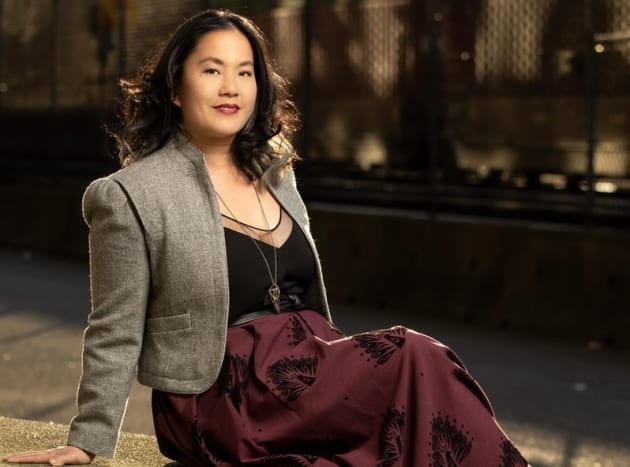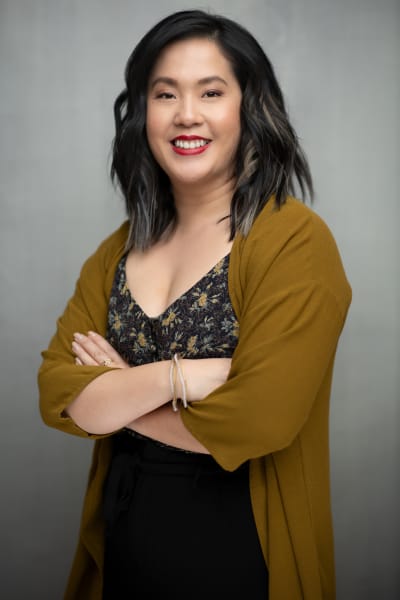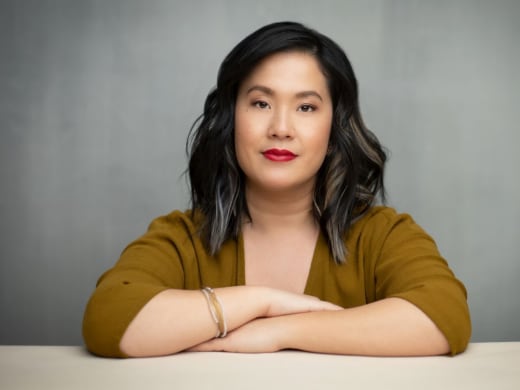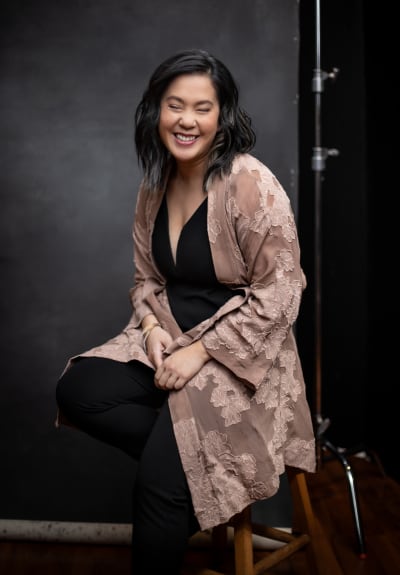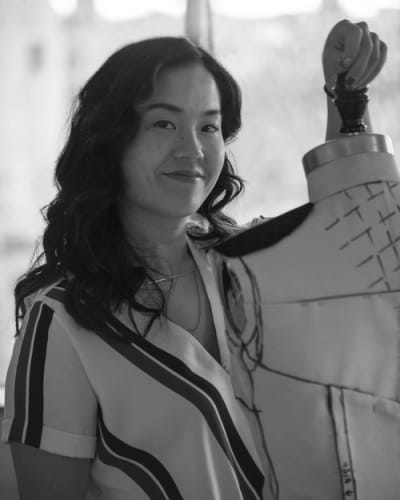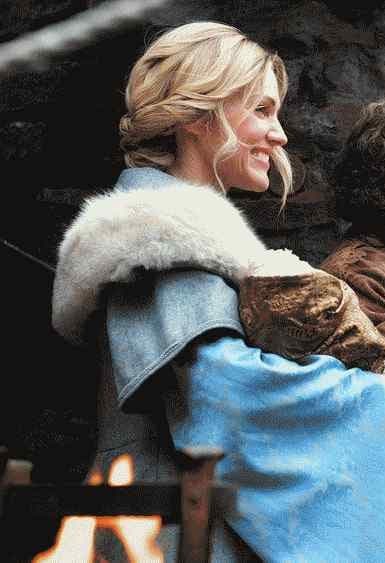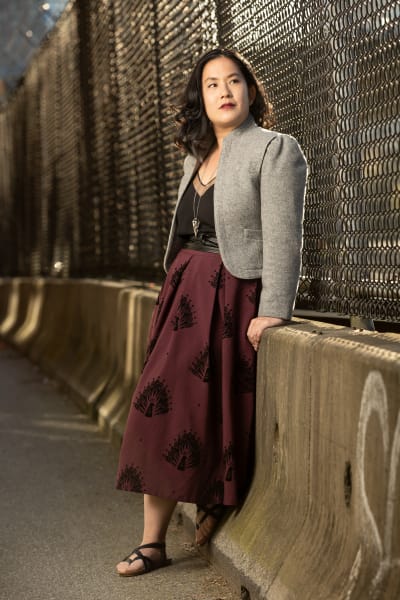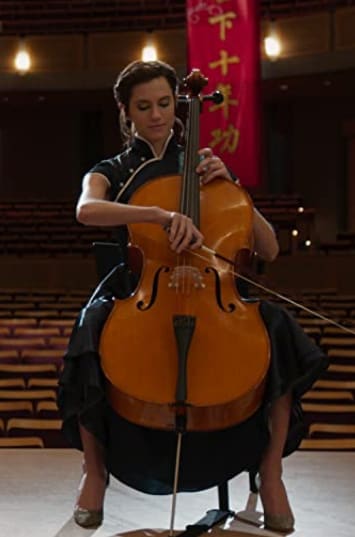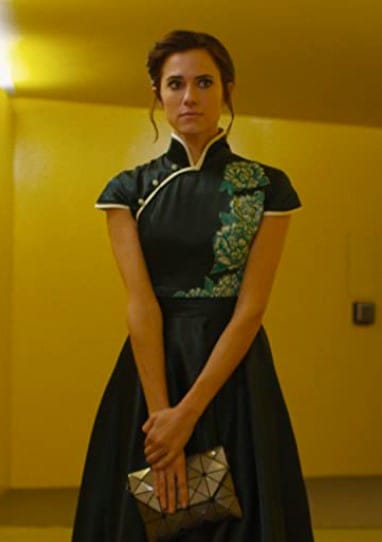Beverley Huynh is a Vancouver-based, internationally-schooled costume designer with a decade of immersive experience in the industry on both the big screen and in television.
While she started out intending to be the next Vera Wang, life introduced her to the world of costuming, and she quickly found her niche, designing costumes for productions that spanned entertainment genres from science fiction to horror to contemporary dramas.
Speaking with TV Fanatic by telephone, she was open to discussing the obstacles she’s had to overcome to achieve her dream as well as the incredible opportunities she has had.
In Huynh’s press kit, her bio includes a descriptive line that begins, “After years of working to achieve what her parents considered an acceptable backup plan…”
Intriguing stuff. What did Huynh’s parents deem “acceptable”?
“It’s so funny that you bring up this question because my parents just actually came to visit. And we just had a really good conversation about immigration struggles.
“When my parents first immigrated to Canada, they had a lot of things to figure out as newly immigrated Canadians and learning the ropes of how this all works.
“And I realized that I came from a family of people who started out very, very poor, with very, very little. And really, ultimately, they just wanted the best for me. But what I also learned it that they didn’t know how to navigate an artistic child.
“What I did learn is my parents are extremely artistic people. They were just never allowed to express it because they couldn’t express it. They were too busy trying to survive. This was a very eye-opening experience, just having this conversation with them this past week.
“When I was going to school, my parents didn’t… couldn’t navigate or teach me how to be a good student. I wasn’t a very good student. They couldn’t grasp that I wasn’t book smart, that I was more a tactical learner. They did everything they could.
“When I was going to school, they just kind of understood I had a knack for business and for understanding how certain things work and when I expressed that I wanted to be a fashion designer, when I was younger, as early as seven years old, their fears and discouragement came from [the fact] that there wasn’t a lot of representation in the industry that I was interested in.
“My mom and I had a conversation basically saying, ‘How many people do you see that look like you that are successful in this field?’ And so, their discouragement came from a place of fear and lack of representation.
“The ‘back-up plan’ was pretty much to go to business school and to learn accounting and learn how to create a business for myself.
“When I got my degree in that, then they were like, ‘Ok, fine, since you keep talking about this, go and study art and go and study fashion design.’ Little did they know that, as my mom put it, ‘One in one thousand people make it as far as you have.’
“[When we talked about this recently,] they admitted that they didn’t know how to navigate this industry and how to help me get to where I am today.
“It was a really humbling conversation to have with my parents.
“I accept it now. It’s taken me this long to really acknowledge that my parents are human, and they did the best that they could. But they didn’t go into it in a full way—honestly, they kind of went into it where I had to pull their teeth.
“I gave them no choice. I was very headstrong. I was just, ‘No, I’m doing this whether you like it or not. You either can support me, or we stop talking to each other.’ I was a very defiant child. [laughs] ‘This is happening whether you like it or not.’
“I think my parents came to the realization that, ‘We can support her and still have a relationship with her, or we can say no to her and never talk to her again.’
“It’s so interesting to hear my parents now talk about it. They had some friends over recently, and they expressed to their friends, ‘We didn’t want her to do this.’
“And it’s so funny because when they were children, my great-grandfather was a tailor. And my mom expressed how, ‘When we were growing up, that was the last thing we wanted to do, and here we are, a generation later, and this is all my daughter can talk about. It’s all she ever wanted.’
“At the end of the day, it’s a little bit like fate, and it’s a little bit like in your blood, so to speak.
“To hear my parents be human and come to the realization that we’re not all built to be doctors, or accountants, or lawyers, or dentists, or whatever high-caliber profession they have in their mind for me, it’s kind of cool.”
While it seems like she burst onto the scene in 2010 with five production credits in that year alone, it wasn’t an immediate jump into Vancouver’s film and television industry for Huynh. She began taking steps towards her dream while still in her teens.
“When I decided this was something I really wanted to do, I would just find ways to build a portfolio so that I could actually present it to the school I went to here in Vancouver.
“I started sketching, drawing, all that stuff. I was a huge theatre kid. I was in the chorus of high school, and we had to do these big presentations to promote the show that we were doing.
“I would always just go up to the director-teacher and say, ‘Hey, can I draw the costumes and put it at the front of the display?’ and they always encouraged that.
“So I kind of had a portfolio going pretty young, but before I moved out to Vancouver, I drove everywhere from Calgary to Edmonton to all the major cities in Alberta, and I would do Time For Print photo shoots for models who were just trying to make it.
“I would go to the stores and buy clothing that I thought was high fashion but really, in reality, what can a young, twenty-one-year-old afford? You know, you can’t go to Holt Renfrew and get that stuff.
“So I’d get items from H&M and just try to style these wannabe fashion models and work with local photographers to fill the portfolio. That’s basically how I got started.
“I wasn’t introduced to film until my boyfriend at the time who I met in Calgary was moving to Vancouver to go to film school.
“I didn’t know that was a thing. I didn’t know that was an option — going to school for film. I thought that was just something that happened in terms of natural talent.
“When I got into fashion school here in Vancouver, I was going down the fashion route until my boyfriend at the time asked me, ‘Hey, would you be interested in just costume designing for a short film?’
“And that’s how I got my start, how I fell in love with film, learning about it behind the scenes.
“I was the kid that would always watch the behind-the-scenes stuff on every DVD that came out at the time. I would watch the entire movie, then I would watch the behind-the-scenes stuff.
Recently, Beverley was tapped to costume design for SyFy’s Van Helsing for its fifth and final season, which shot partly in Slovakia. The season’s challenge included creating an entirely new look for the cast as the show time-jumped back to Dracula’s origin story.
“I love mixing and matching historical costuming. I was very, very fortunate that before we even went to Slovakia, our showrunner, Jonathan Walker, gave me a heads up.
“He’s like, ‘Hey, we’re looking into 17th maybe 18th century Slovakia. We’re looking into these 16th-century castles, very Gothic era.’ So he gave me ample time for research.
“It just made me very, very happy because, at the end of Season 4, I expressed to him that I would love to come back for Season 5, not knowing that it would be the final season.
“The fact that he reached out and just said, ‘Hey, this is what we’re expecting to do. We’re traveling to Europe. We’re looking into this. If you’re on board, we’d love to have you come and make the costumes for us,’ I was extremely grateful and very, very lucky that they agreed to let me come on and do those things.
“And, of course, because they’re a fantastical world — [their] Dracula is very sci-fi — the beautiful thing is that we didn’t have to be a hundred percent accurate maybe because, during that time, the fashions of London and Paris hadn’t even made it to Transylvania, never made it to Slovakia.
“So you’re kind of in this weird [situation] of being able to mix 17th, 18th, and 19th-century influences.
“And I LOVE Michele Clapton’s work [on Game of Thrones]. She was a big, big influence. While I was living in London, England, I was able to tour her work. I was able to kind of be up and close and personal to the workshops that were creating that work.
“I drew a lot of influence from her and her way of thinking and pulled certain details. Of course, not on the same level of budget as Game of Thrones, but we were able to meld all these different historical choices together.
“Slovakia was just an incredible challenge and just a great opportunity for me to dive into the type of work you don’t always get to do in Vancouver.
“Vancouver is very hyper-focused on sci-fi but modern and superhero-type stuff. I had immense support with my team in Slovakia, where we were able to go to Austria and get the right fabric and get the right tools.
“Not only that, [we] had the opera sewing team to create the pieces in a short amount of time but with an immense amount of work ethic and beautiful detail. I was amongst an incredible group of people to help me execute my ideas. It was incredible, an incredible opportunity.”
Another opportunity that presented itself in the Van Helsing Season 5 production was dressing actress Tricia Helfer in her pre-Dracula days when her character was Lady Olivia, a dramatically different individual.
“I mean, I am so lucky. I could put [Tricia Helfer] in a paper bag, and she’d look phenomenal in it. This woman could wear anything. So I am extremely lucky that I had a muse like her to work with.
“But not only that, she has a gracious heart, and she is just open to ideas and open to anything. I, of course, kept her in the loop. Her story arc has her starting out pure of heart and being taken over by this darkness
“In Season 4, I got to dress her. I created the color palette for our darker character, which was a blend of blacks, greys, and navy.
“[In Season 5], for her story arc, we got to go into a softer palette for her. And the funny thing is that her costume when I originally designed it, it started out to be pink, gold, and purple because I wanted to show off her royalty.
“But by the time we got to Slovakia, to get the fabrics and the materials we needed, the colors that I originally wanted were unavailable.
“So I had to adapt, and we managed to find what I was looking for in blues which turned out to be perfect because Tricia herself has these beautiful blue piercing eyes, and putting her in blue really showcased that and showed it off.
“Tricia is one of those actors that are so incredibly gracious that I’d messaged her and I’d asked her for input, but she’s just like, ‘I’ll do whatever you want. Just tell me what you have in mind.’ She’s game for it.
“Y’know, you get some actors that are just very acute and aware of what they want, and I love working with that equally, but when you have someone like Tricia who gives you full support and full trust that you’re going to do everything in your power to make them look great — not that Tricia needs it at all like I said, she can wear anything — it gives you a lot of room to just not have to be restricted with what the actor has in mind.
“There’s just so much trust with Tricia, and it’s so easy to work with her because she’s just like, ‘Yeah, go for it. I’ll rock whatever you put me in,’ and it’s true.
“And I think, honestly, with her background with coming from the modeling world, of just having to wear whatever — whatever our personal opinion of it is — she just rocks it because that’s what’s been given to her. It was a great experience because she was an insane muse. It was just so easy to dress her.”
As Huynh mentioned, Van Helsing’s foray into the past, a style of costuming that she doesn’t often get to work with. So how does the fantasy historical genre compare to dressing a more modern look?
“In my personal opinion, contemporary is exceptionally hard because the thing with contemporary look is that that’s when you get talent who come in with an opinion and an idea because we see contemporary looks every day.
“So they have a particular image or ideas in mind, which isn’t a bad thing at all. It’s just when you have a certain idea and whether it’s not communicated clearly, or you just can’t find the right pieces.
“You could be in the middle of summer, and somebody has in mind this thick, wool sweater that you can’t possibly get at the moment or a leather jacket in the middle of winter. Those things are really hard to come by. So you really have to be resourceful with what you find.
“It’s like cooking. Making a clean, simple dish is the hardest thing to do because you only have the ingredients in front of you to speak for itself, and I think creating a simple, clean, modern character is the same thing.
“You have a limited amount of options to express what this going to say about this particular character and this person. So modern is definitely harder to do because if you’re working with a show like Van Helsing where you need multiples and you need the same of a lot of things, you’re limited by how many you can get of that item and how many you can get destroyed because you shoot everything out of sequence.
“So simplicity and the modern look is the harder thing [compared to] being able to create from scratch, for sure. I equally love the challenge because it’s fun when you get fun, quirky characters because they’re not just limited to a pair of jeans and a jacket and a t-shirt.
On the other end of the physical spectrum from the slim Helfer, but also a major player on Van Helsing is Julius, played by Aleks Paunovic. Huynh’s ingenuity comes into play when the proportions just aren’t something off-the-rack is going to work for.
“For him, it was fun because, again, Aleks is the same thing. He’s game. He’s up for it. He’s just like, ‘Yeah, you can just put me in whatever.’
“But when you’re dealing with Aleks who’s six foot five, you can’t always get the right shirt with the right sleeve length.
“A perfect example is, in Season 5, we got him the perfect denim jacket, but we couldn’t get it in the right sleeve length, so what we ended up doing was getting multiples of the same jacket and cutting fabric from an XXXXXL and extending the sleeve and making it longer. So you have to get really creative with being able to do things like that.
“You just have to try your best to find what you can find and adjust accordingly, tailoring it to the person so that it works and fits properly. Stuff like that, you just come up with a creative solution.
While she’s explored many different genres so far in her career, Huynh still dreams of something bigger.
“I want to create an entire world. That would be a dream project if I could have something like The Cell or Gattaca or completely otherworldly that isn’t defined by what we see before. I would love to do something like that.
“Things that I could draw influence from multiple cultures. I’ve been super lucky so far, but if I could be the one which defines a world and creates a particular group of people, that would be the dream project.”
In the meanwhile, she has several exciting projects in the works.
“I just finished the film for Netflix called The Last Will and Testament of Charles Abernathy. It is a horror film. It is set in modern times, but I got to play in a little bit more of a fashion-type world which is a little bit more fun.
“And my next upcoming project will be a Lionsgate feature film that will explore a coming-of-age story of Asian immigrants, which I’m super excited about. It’ll be shooting and starting prep in August.”
With her interest and drive to incorporate diverse cultural styles into her costuming, has Huynh had the opportunity to explore Asian motifs? In a story rife with serendipity, she tells us how that door opened for her.
“I was very lucky. You know, my career and my life has always been a series of just ‘you’re in the right place at the right time’ type moments.
“I had just finished a trip to Shanghai and Southeast Asia. And I was exploring the art district, and I came across this beautiful shop that had traditional Mandarin-collared Chinese dresses.
“[One dress] had a hand-painted violin on it, and I was just fascinated by it. I took photos of it and had a great time talking to the shopkeeper about it.
“Then, when I was in Indonesia, I had a phone call asking if I would read a script for Miramax. And I said yes. And I read it. And the opening scene is set in Shanghai, and it was about two cellists competing with one another.
“I was like, ‘What the hell?’ I was like, ‘This is it. This is the one. This is mine. I can feel it.’ And I came back to Vancouver and did the pitch and did the interview with the creators, and it turned out to be The Perfection with Allison Williams and Logan Browning. It’s on Netflix.
“I was talking to the director and the executive producer, and they said, ‘We hired you because you said you literally got off the plane and came back from Shanghai.”
“And so, my life with projects coming to fruition and coming across me has always had some type of story like that attached to it. For that one, I got to take all the inspiration that I got when I was in Shanghai.
“Allison Williams’s green dress that she wears in the yellow background when she first arrives to meet her mentor in the film is based off of that dress that I was fascinated by in Shanghai. It had hand-painted flowers on it, which I painted.
Remembering what Huynh’s parents thought about how Asians weren’t represented in the fashion industry, does she feel like it has changed? Does she see herself as part of that change?
“I’d like to hope that I am becoming the face that I wish I had seen more of when I was younger. I mean, one of the first influences of positive recognition of Asian people in the industry [was] when I saw Vera Wang for the first time.
“And I think that the main thing that changed everything for me was in much later years, was when Crazy Rich Asians came out. That was one of those moments where I realized how important it was to have someone to look up to.
“It was the first time that I resonated with the lead character’s story of being Asian-American and not fully belonging in New York City even though she’s a New Yorker but then traveling to be with her fiance and not fully fitting in because she’s not fully Asian either.
“That was the first time where I recognized that story as my own because I had the exact same experience when I traveled to Shanghai, to Southeast Asia.
“I’m Canadian-born. I always felt like an outsider but not fully being attached to my roots either because I”m trying to fit in so badly that I kind of disconnected from my roots. And it’s not until now, as an adult, that I’m fully embracing my roots and my culture.
“But when I traveled to Southeast Asia, I stuck out as someone who looked like everyone else, but I couldn’t speak the language because I’m not Chinese. I’m Vietnamese. I got a lot of backlash.
“The funniest thing was I took a class with some German people who’d been living there for two years, and they could speak Mandarin whereas I couldn’t.
“When we were leaving this class, we were trying to find the exit, and an old gentleman saw me, and he was berating me, yelling at me in Chinese, and I couldn’t respond, just stood there with a deer in the headlights type look on my face.
“And the German people beside me were saying in Mandarin, ‘She doesn’t speak Chinese,’ and he continued to scream and yell at me as if to say, ‘How dare you be here and not be able to speak the language?’
“It was a sense of loneliness that I’d never felt before. I looked like everybody else, but I still felt like I didn’t belong.
“It was just a weird place of limbo to feel like you’re in when, back home, you don’t really feel at home because you’re a minority and you’re judged for that minority, but then to go to a place where you are part of that group and community of people, but you still can’t communicate.
“That’s why I hope that I am that voice and that influence now for other people who are going through the same thing. I think it’s important that we have representation. And I do see it changing. I do see more stories coming out.
“The story that I’ll be working on in August is a big part of that change, and I’m happy to be part of an industry that is working to change how they portray minorities.
Recognizing that representative change has to start with making opportunities available to young people of all backgrounds to provide them with the training and skills to make them competitive in the industry, Huynh is looking for ways of providing the leadership that she would’ve liked to have had when she was starting out.
“I’m currently working with a group in LA to try and create more of a group-mentoring environment.
“I’m just learning more about my identity and how I’d like to use my voice to create that safe space and create that space for others to be able to be heard.
“I am currently doing more research and looking into how I can be more involved with our community, especially young girls mainly because I’ve been wanting to do more of this type of philanthropic work and using my voice in a positive way.
“Right now, for me, it’s a learning curve as to how I can get more involved with my communities and how I can do that in a positive way. I’m currently in the process of doing my research and finding the right groups to be a part of.”
Look for Beverley Huynh’s work in the upcoming Netflix horror film, The Last Will and Testament of Charles Abernathy, and follow her work on Instagram (@bevwincostumes).
Diana Keng is a staff writer for TV Fanatic. Follow her on Twitter.
